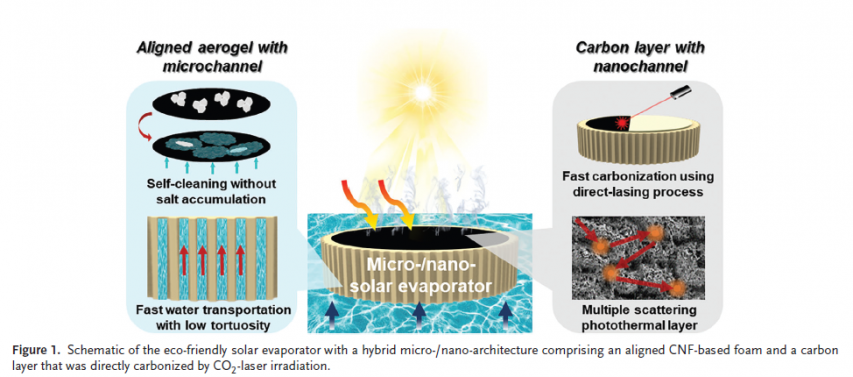[Feature] Cellulose-based Photothermal Evaporator: A Step Toward Securing Sustainable Water Resources
On November 17, 2024, a research team led by Professor You Jung-mok from Kyung Hee University’s Dept. of Plant & Environmental New Resources announced the new paper Nanocellulose-Based Interfacial Solar Evaporatoer: Integrating Sustainable Materials and Micro-/Nano-Architectures for Solar Desalination. The research was published in Advanced Functional Materials.

Overall functions of the cellulose-based photothermal evaporator
Photo: Advanced Functional Materials (advanced.onlinelibrary.wiley.com)
Addressing the Global Water Crisis
Driven by the decline in global scarcity of clean water resources, Prof. You turned his focus to seawater desalination. Citing United Nations’ data, he noted that one-fifth of the world’s population is currently facing water scarcity due to environmental pollution. Prof. You emphasized, “As clean water resources become scarce, seawater desalination technology is a practical solution as seawater covers 70% of the Earth’s surface.”
There are various ways of desalinating seawater, such as reverse osmosis, freezing, and multi-stage flash. However, Prof. You noted these technologies have limitations, including complex equipment, high infrastructure costs, low efficiency, and secondary pollution caused by fossil fuel usage.
To overcome these challenges, Prof. You chose to focus on evaporation-based desalination. This process removes salt in seawater through evaporation and condenses the remaining vapor to produce clean water. The traditional evaporation methods have been inefficient due to significant heat loss and low evaporation efficiency. This solar-driven evaporation method reduces heat loss and achieves an excellent photothermal conversion efficiency of over 90%.
Developing the Cellulose-based Solar Evaporator
The research team went further, deciding to eliminate synthetic polymers in the evaporator to reduce toxic substances. Prof. You stated, “In our research, we aimed to develop an eco-friendly photothermal evaporator based on cellulose to prevent the generation of microplastics and toxic substances.”
The research team invented the photothermal evaporator using cellulose. Prof. You explained, “Cellulose is one of the world’s most abundant eco-friendly polymeric materials and is particularly suitable for the photothermal evaporator due to its high hydrophilicity and low heat conductivity.” The research team created cellulose nanofibrils (CNF) through the fibrosis process. Subsequently, the CNF was liquefied and rapidly frozened to form a cellulose aerogel (CA), which serves as the main structure of the photothermal evaporator. “CA exhibits higher biodegradability than synthetic polymers, which enhances water supply performance and improves evaporation efficiency,” said Prof. You.
Key Innovations in Research
To improve previous evaporators’ water supply and heat absorption efficiency, the team implemented two key processes. The first process is ice-templating, a rapid freezing method, which was used to create specific structures within a substance. The process is applied in the formation of a homogeneous porous structure. The porous structure facilitated the seawater supply, as well as improving the evaporation efficiency through the large surface area. In addition, the porous structure has a self-cleaning function. During the desalination process, the performance of the evaporator often becomes hindered by the accumulation of salt. However, the porous structure of the cellulose-based evaporator enables salt to be expelled through the continuous water flow, preventing the issue.
The research team mentioned formation of the porous structure was the biggest difficulty of the research. Prof. You explained, “In early experiments, the structure was often unevenly formed or did not follow the desired direction.” However, these difficulties were solved by carefully setting the conditions for ice-templating. As a result, all the water desalinated during the experiment met the World Health Organization’s drinking standards.
The second process is the Carbon Dioxide (CO2) laser carbonization process. To further enhance photothermal absorption and conversion efficiency, the team used CO2 laser carbonization to create a thin carbon layer on the evaporator’s surface. Prof. You explained, “The previous carbonization process required large amounts of energy and lacked precision. In contrast, CO2 laser carbonization can be used by developing countries due to its lower cost and simpler technology and it can formulate a more elaborate carbon layer with low energy consumption.”
The process of producing cellulose-based photothermal evaporator through ice-templating and carbonization
Photo: Advanced Functional Materials (advanced.onlinelibrary.wiley.com)
Potential Applications and Future Research
As a result, this research significantly enhanced the efficiency of photothermal evaporators. Prof. You stated, “Considering the evaporation efficiency of the previous photothermal evaporator was only 70-80%, this research achieved a 15-20% improvement of the evaporation efficiency.”
The cellulose-based evaporator has potential application in various fields in water-deficient areas, purification of agricultural water, and industrial wastewater treatment. It could be very beneficial to developing countries in maintaining drinking water and public health. Prof. You further noted, “This study can contribute to the United Nations Sustainable Development Goals, particularly Goal 6 on Clean Water and Sanitation and Goal 13 on Climate Action.”
The research team is now preparing for follow-up research and commercialization. Prof. You explained, “We are looking for ways to cooperate with international organizations and non-governmental organizations so that this technology can have a practical impact in various regions, including developing countries.”
In addition, the research team plans to expand experiments for practical use and conduct performance verification in various environments. Prof. You mentioned, “The study has been conducted in the laboratory and actual solar conditions, but long-term stability evaluation in real-world environments is needed. In future studies, we plan to verify the performance in various climate conditions and study the possibility of mass production of fresh water using evaporators.” With continued effort, Prof. You’s research raises high expectations for the future of seawater desalination and its potential to address water scarcity.
- 1
- 2
- 3
I agree to the collection of personal information.




